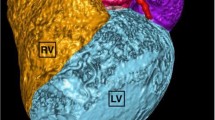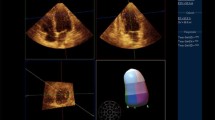Abstract
To evaluate the agreement between dual-source computed tomography (DSCT) and two-dimensional transthoracic echocardiography (2D-TTE) with respect to the assessment of global left ventricular (LV) function in patients with severe arrhythmia. With 2D-TTE serving as the reference method, we performed both DSCT and 2D-TTE, at an interval of less than 2 days, in 54 patients with severe arrhythmia (average heart rate difference >30 beats per min) before open heart surgery for evaluation of valvular heart disease (VHD) and coronary artery disease. DSCT was performed using retrospective electrocardiography (ECG) without dose modulation. Ten phases of the cardiac cycle were analyzed for identification of end-diastolic and end-systolic phases with ECG-editing. Pearson’s correlation coefficient (r) and Bland–Altman analysis were used to determine agreement for parameters of LV global function. Correlation between DSCT and 2D-TTE measurements was good or excellent in terms of the values of the LV ejection fraction (51.0 ± 11.4% vs. 55.8 ± 11.6%; r = 0.8), LV end-diastolic volume (179.5 ± 98.6 ml vs. 152.1 ± 73.8 ml; r = 0.95), LV end-systolic volume (90.7 ± 60.7 ml vs. 69.1 ± 46.8 ml; r = 0.90), and LV stroke volume (89.0 ± 48.1 ml vs. 82.9 ± 37.3 ml; r = 0.89). Left ventricular ejection fraction measured using DSCT was less than that measured using 2D-TTE by an average of −4.8 ± 7.3%. Dual-source CT with ECG editing can provide results comparable to those of 2D-TTE for assessment of LV global function in patients with severe arrhythmia.


Similar content being viewed by others
Abbreviations
- AF:
-
Atrial fibrillation
- DSCT:
-
Dual-source multidetector computed tomography
- ECG:
-
Electrocardiography
- EF:
-
Ejection fraction
- LV:
-
Left ventricle
- LVEF:
-
Left ventricular ejection fraction
- LVEDV:
-
Left ventricular end-diastolic volume
- LVESV:
-
Left ventricular end-systolic volume
- MDCT:
-
Multi-detector computed tomography
- MRI:
-
Magnetic resonance imaging
- 2D:
-
Two dimensional
- 2D-TTE:
-
Two dimensional transthoracic echocardiography
- VHD:
-
Valvular heart disease
References
Schocken DD, Arrieta MI, Leaverton PE et al (1992) Prevalence and mortality rate of congestive heart failure in the United States. J Am Coll Cardiol 20(2):301–306
White HD, Norris RM, Brown MA et al (1987) Left ventricular end-systolic volume as the major determinant of survival after recovery from myocardial infarction. Circulation 76(1):44–51
Gerber TC, Behrenbeck T, Allison T et al (1999) Comparison of measurement of left ventricular ejection fraction by Tc-99 m sestamibi first-pass angiography with electron beam computed tomography in patients with anterior wall acute myocardial infarction. Am J Cardiol 83(7):1022–1026
Fuster V, Rydén LE, Cannom DS et al (2006) ACC/AHA/ESC 2006 Guidelines for the Management of Patients with Atrial Fibrillation: a report of the American College of Cardiology/American Heart Association Task Force on Practice Guidelines and the European Society of Cardiology Committee for Practice Guidelines (Writing Committee to Revise the 2001 Guidelines for the Management of Patients With Atrial Fibrillation): developed in collaboration with the European Heart Rhythm Association and the Heart Rhythm Society. Circulation 114(7):e257–e354
Bellenger NG, Burgess MI, Ray SG et al (2000) Comparison of left ventricular ejection fraction and volumes in heart failure by echocardiography, radionuclide ventriculography and cardiovascular magnetic resonance; are they interchangeable? Eur Heart J 21(16):1387–1396
Schiller NB, Acquatella H, Ports TA et al (1979) Left ventricular volume from paired biplane two-dimensional echocardiography. Circulation 60(3):547–555
Pons-Lladó G (2005) Assessment of cardiac function by CMR. Eur Radiol 15(Suppl 2):B23–B32
Orakzai SH, Orakzai RH, Nasir K et al (2006) Assessment of cardiac function using multidetector row computed tomography. J Comput Assist Tomogr 30(4):555–563
Juergens KU, Fischbach R (2006) Left ventricular function studied with MDCT. Eur Radiol 16(2):342–357
Mahnken AH, Mühlenbruch G, Gunther RW et al (2007) Cardiac CT: coronary arteries and beyond. Eur Radiol 17(4):994–1008
Ko SM, Kim YJ, Park JH et al (2010) Assessment of left ventricular ejection fraction and regional wall motion with 64-slice multidetector CT: a comparison with two-dimensional transthoracic echocardiography. Br J Radiol 83(985):28–34
Dewey M, Müller M, Eddicks S et al (2006) Evaluation of global and regional left ventricular function with 16-slice computed tomography, biplane cineventriculography, and two-dimensional transthoracic echocardiography: comparison with magnetic resonance imaging. J Am Coll Cardiol 48(10):2034–2044
Salm LP, Schuijf JD, de Roos A et al (2006) Global and regional left ventricular function assessment with 16-detector row CT: comparison with echocardiography and cardiovascular magnetic resonance. Eur J Echocardiogr 7(4):308–314
Mahnken AH, Bruners P, Stanzel S et al (2009) Functional imaging in the assessment of myocardial infarction: MR imaging vs. MDCT vs. SPECT. Eur J Radiol 71(3):480–485
Schepis T, Gaemperli O, Koepfli P et al (2006) Comparison of 64-slice CT with gated SPECT for evaluation of left ventricular function. J Nucl Med 47(8):1288–1294
Wu YW, Tadamura E, Yamamuro M et al (2008) Estimation of global and regional cardiac function using 64-slice computed tomography: a comparison study with echocardiography, gated-SPECT and cardiovascular magnetic resonance. Int J Cardiol 128(1):69–76
Wu YW, Tadamura E, Kanao S et al (2008) Left ventricular functional analysis using 64-slice multidetector row computed tomography: comparison with left ventriculography and cardiovascular magnetic resonance. Cardiology 109(2):135–142
Henneman MM, Schuijf JD, Jukema JW et al (2006) Assessment of global and regional left ventricular function and volumes with 64-slice MSCT: a comparison with 2D echocardiography. J Nucl Cardiol 13(4):480–487
Bansal D, Singh RM, Sarkar M et al (2008) Assessment of left ventricular function: comparison of cardiac multidetector-row computed tomography with two-dimension standard echocardiography for assessment of left ventricular function. Int J Cardiovasc Imaging 24(3):317–325
Brodoefel H, Burgstahler C, Tsiflikas I et al (2008) Dual-source CT: effect of heart rate, heart rate variability, and calcification on image quality and diagnostic accuracy. Radiology 247(2):346–355
Gottdiener JS, Bednarz J, Devereux R et al (2004) American Society of Echocardiography recommendations for use of echocardiography in clinical trials. J Am Soc Echocardiogr 17(10):1086–1119
Schiller NB, Shah PM, Crawford M et al (1989) Recommendations for quantitation of the left ventricle by two-dimensional echocardiography. American Society of Echocardiography Committee on Standards, subcommittee on quantitation of two-dimensional echocardiograms. J Am Soc Echocardiogr 2(5):358–367
Folland ED, Parisi AF, Moynihan PF et al (1979) Assessment of left ventricular ejection fraction and volumes by real-time, two-dimensional echocardiography. A comparison of cineangiographic and radionuclide techniques. Circulation 60(4):760–766
Tops LF, Krishnàn SC, Schuijf JD et al (2008) Noncoronary applications of cardiac multidetector row computed tomography. JACC Cardiovasc Imaging 1(1):94–106
Johnson TR, Nikolaou K, Wintersperger BJ et al (2006) Dual-source CT cardiac imaging: initial experience. Eur Radiol 16:1409–1415
Rist C, Johnson TR, Becker A et al (2007) Dual-source cardiac CT imaging with improved temporal resolution: impact on image quality and analysis of left ventricular function. Radiologe 47(4):287–290, 292–294 [German]
Gosselink AT, Blanksma PK, Crijns HJ et al (1995) Left ventricular beat-to-beat performance in atrial fibrillation: contribution of Frank-Starling mechanism after short rather than long RR intervals. J Am Coll Cardiol 26(6):1516–1521
Mahnken AH, Spuentrup E, Niethammer M et al (2003) Quantitative and qualitative assessment of left ventricular volume with ECG-gated multislice spiral CT: value of different image reconstruction algorithms in comparison to MRI. Acta Radiol 44(6):604–611
Juergens KU, Maintz D, Grude M et al (2005) Multi-detector row computed tomography of the heart: does a multi-segment reconstruction algorithm improve left ventricular volume measurements? Eur Radiol 15(1):111–117
Mahnken AH, Hohl C, Suess C et al (2006) Influence of heart rate and temporal resolution on left-ventricular volumes in cardiac multislice spiral computed tomography: a phantom study. Invest Radiol 41(5):429–435
Mahnken AH, Bruder H, Suess C et al (2007) Dual-source computed tomography for assessing cardiac function: a phantom study. Invest Radiol 42(7):491–498
Bastarrika G, De Cecco CN, Arraiza M et al (2008) Dual-source CT for visualization of the coronary arteries in heart transplant patients with high heart rates. AJR Am J Roentgenol 191:448–454
Matt D, Scheffel H, Leschka S et al (2007) Dual-source CT coronary angiography: image quality, mean heart rate, and heart rate variability. AJR Am J Roentgenol 189(3):567–573
Weustink AC, Neefjes LA, Kyrzopoulos S et al (2009) Impact of heart rate frequency and variability on radiation exposure, image quality, and diagnostic performance in dual-source spiral CT coronary angiography. Radiology 253(3):672–680
Gutiérrez-Chico JL, Zamorano JL, Pérez de Isla L et al (2005) Comparison of left ventricular volumes and ejection fractions measured by three-dimensional echocardiography versus by two-dimensional echocardiography and cardiac magnetic resonance in patients with various cardiomyopathies. Am J Cardiol 95(6):809–813
Ko SM, Kim NR, Kim DH et al (2010) Assessment of image quality and radiation dose in prospective ECG-triggered coronary CT angiography compared with retrospective ECG-gated coronary CT angiography. Int J Cardiovasc Imaging 26 (Suppl 1):93–101
Husmann L, Valenta I, Gaemperli O et al (2008) Feasibility of low-dose coronary CT angiography: first experience with prospective ECG-gating. Eur Heart J 29(2):191–197
Stolzmann P, Leschka S, Scheffel H et al (2008) Dual-source CT in step-and-shoot mode: noninvasive coronary angiography with low radiation dose. Radiology 249(1):71–80
Leschka S, Scheffel H, Husmann L et al (2008) Effect of decrease in heart rate variability on the diagnostic accuracy of 64-MDCT coronary angiography. AJR Am J Roentgenol 190(6):1583–1590
Yamakado T, Okano S, Higashiyama S et al (1985) Effects of nitroglycerin on left ventricular systolic, diastolic and regional myocardial function in patients with coronary artery disease. J Cardiogr 15(2):273–284 Japanese
Acknowledgments
This work was supported by Konkuk University in 2010. The authors would like to thank the CT technologists, the radiology department nursing staff, the cardiology department staff physicians and the residents in the Division of Thoracic Surgery at the Konkuk University Hospital.
Author information
Authors and Affiliations
Corresponding author
Rights and permissions
About this article
Cite this article
Kim, S.S., Ko, S.M., Song, M.G. et al. Assessment of global function of left ventricle with dual-source CT in patients with severe arrhythmia: a comparison with the use of two-dimensional transthoracic echocardiography. Int J Cardiovasc Imaging 26 (Suppl 2), 213–221 (2010). https://doi.org/10.1007/s10554-010-9692-2
Received:
Accepted:
Published:
Issue Date:
DOI: https://doi.org/10.1007/s10554-010-9692-2




